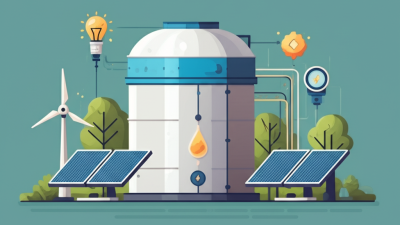Exploring the Advantages of Liquid Storage Tanks for Sustainable Energy Solutions
As the global transition towards sustainable energy solutions accelerates, the role of liquid storage tanks has become increasingly vital in the energy sector. These tanks provide not only a means to store essential liquids, such as biofuels and renewable energy resources, but also enable flexibility and reliability in energy supply. According to a report by the International Energy Agency (IEA), the global demand for liquid storage tanks is projected to grow by 6% annually through 2025, driven by the rise in renewable energy installations and advancements in liquid fuels technology. Utilizing liquid storage tanks facilitates the management of intermittent energy generation, particularly from sources like solar and wind power. Furthermore, the storage capacity they offer helps mitigate the volatility in energy prices and ensures that sustainable energy solutions can be effectively implemented and scaled. In this article, we will explore the numerous advantages of liquid storage tanks in supporting a more resilient and sustainable energy infrastructure.

Benefits of Liquid Storage Tanks in Renewable Energy Systems
Liquid storage tanks play a crucial role in the advancement of sustainable energy solutions, particularly within renewable energy systems. One of the primary benefits of these tanks is their ability to store large volumes of energy in the form of liquid fuels, which can be derived from various renewable resources. This not only helps in balancing energy supply and demand but also enables better integration of renewable sources like solar and wind into the energy grid, effectively reducing reliance on fossil fuels.
Tip: When selecting a liquid storage tank, it's vital to consider the material and insulation properties, as these factors will influence the efficiency and safety of energy storage. Opting for tank designs that use advanced insulating materials can greatly enhance temperature control, ensuring that liquids remain stable regardless of external conditions.
Furthermore, liquid storage tanks facilitate smoother transitions during energy shortages. By maintaining a reserve of biofuels or other renewable liquids, energy providers can ensure a consistent supply even during periods of low production. This stability is particularly beneficial for energy-intensive industries looking to minimize disruptions.
Tip: Regular maintenance of liquid storage tanks is essential. Implement a routine inspection schedule to check for leaks and ensure compliance with safety standards, as this can prevent costly accidents and enhance the longevity of the storage system.
Cost-Effectiveness of Liquid Storage Solutions for Sustainable Projects
Liquid storage tanks play a crucial role in the development of sustainable energy projects, particularly in enhancing cost-effectiveness. These tanks can efficiently store various fluids, including biofuels, water, and other renewable resources, allowing for better resource management and optimized usage. By minimizing waste and ensuring that energy resources are readily available, these storage solutions help reduce overall project costs, making them an attractive option for organizations focused on sustainable practices.
Furthermore, the implementation of advanced technologies in liquid storage tank design has significantly increased their efficiency and durability. High-quality materials and innovative engineering not only extend the lifespan of these tanks but also reduce maintenance costs over time. This translates to lower operational expenses for sustainable projects, enabling stakeholders to allocate funds towards further development and expansion of renewable energy initiatives. The affordability and practicality of liquid storage systems underscore their importance in the transition towards more sustainable energy alternatives.
Maximizing Efficiency: How Liquid Tanks Optimize Energy Storage
Liquid storage tanks play a crucial role in maximizing efficiency in energy storage systems, particularly for sustainable energy solutions. According to a report by the International Energy Agency (IEA), the demand for energy storage solutions is expected to grow significantly, with an estimated increase of 150% in global storage capacity by 2030. Liquid tanks provide a reliable means of storing renewable energy generated from sources like wind and solar, allowing for a seamless transition of power during peak demand periods.
The efficiency of liquid storage tanks can be attributed to their ability to minimize energy loss during the storage process. Research conducted by the Energy Storage Association indicates that liquid energy storage can achieve round-trip efficiencies of up to 90%. This is particularly advantageous when integrating with grid systems, as it enables energy producers to store excess energy generated during low-demand periods and release it when the demand is higher.
Furthermore, the scalability of liquid storage solutions allows for the expansion of capacity in response to growing energy needs, making them a versatile option for future sustainable energy infrastructures.
Environmental Impact: Reducing Carbon Footprint with Liquid Tanks
Liquid storage tanks play a crucial role in advancing sustainable energy solutions, significantly contributing to the reduction of carbon footprints in various sectors. According to a report by the Global Energy Storage Alliance, the adoption of liquid storage systems can decrease greenhouse gas emissions by up to 30% when replacing conventional fossil fuel storage methods. These tanks facilitate the integration of renewable energy by efficiently storing excess energy from sources such as wind and solar, thus promoting energy efficiency and sustainability.
Moreover, the use of specialized materials and advanced design technologies in the construction of liquid storage tanks enhances their environmental performance. A study published in the Journal of Environmental Management indicates that tanks designed with eco-friendly materials can reduce leakage risks and improve overall lifecycle impacts, achieving a carbon reduction of approximately 15% from their traditional counterparts. As industries move towards greener practices, liquid storage tanks prove to be a viable solution, not only streamlining energy storage but also actively participating in the fight against climate change.
Innovative Technologies Enhancing Liquid Storage for Energy Solutions
Innovative technologies are playing a pivotal role in enhancing liquid storage solutions that cater to sustainable energy needs. With the growing emphasis on renewable energy sources, liquid storage tanks have become essential for managing the intermittency of solar and wind energy. A recent report from MarketsandMarkets indicates that the liquid storage market is projected to reach $22.5 billion by 2025, reflecting a compound annual growth rate (CAGR) of 11.2%. This growth underscores the increasing reliance on sophisticated storage strategies to ensure energy availability and stability.
The integration of smart technologies, such as IoT sensors and AI-driven monitoring systems, allows for real-time data analysis and improved tank management. These innovations not only enhance efficiency but also contribute to reducing operational costs. For instance, predictive maintenance can minimize downtime, prolonging the lifespan of storage tanks. According to a report by the International Energy Agency, the adoption of such advanced technologies can lead to a reduction in energy waste by up to 20%, significantly boosting the overall sustainability of energy solutions.
**Tip:** When investing in liquid storage tanks, consider solutions equipped with smart monitoring systems to gain insights into tank performance and maintenance needs. Additionally, explore modular storage designs, which can be tailored to project requirements, ensuring efficiency and scalability.
Exploring the Advantages of Liquid Storage Tanks for Sustainable Energy Solutions
| Dimension | Description | Advantages | Innovative Technologies |
|---|---|---|---|
| Capacity | Volume of liquid that can be stored | Allows for bulk storage and efficient management of resources | Advanced leak detection systems |
| Material | Types of materials used for construction | Durability and resistance to corrosion | Composite materials with enhanced properties |
| Insulation | Method of thermal insulation applied | Energy efficiency and reduced heat loss | Reflective insulating materials |
| Safety Features | Safety mechanisms in place | Minimizes risk of spills and environmental impacts | Automatic shut-off valves and monitoring systems |
| Location | Site of installation | Adaptability to various environments | Mobile storage units for remote locations |

